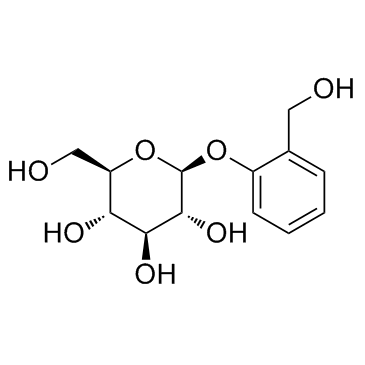D-(-)-Salicin

D-(-)-Salicin structure
|
Common Name | D-(-)-Salicin | ||
|---|---|---|---|---|
| CAS Number | 138-52-3 | Molecular Weight | 286.278 | |
| Density | 1.5±0.1 g/cm3 | Boiling Point | 549.1±50.0 °C at 760 mmHg | |
| Molecular Formula | C13H18O7 | Melting Point | 196-202 °C | |
| MSDS | Chinese USA | Flash Point | 285.9±30.1 °C | |
| Symbol |

GHS07 |
Signal Word | Warning | |
|
Aspen defense chemicals influence midgut bacterial community composition of gypsy moth.
J. Chem. Ecol. 41(1) , 75-84, (2015) Microbial symbionts are becoming increasingly recognized as mediators of many aspects of plant - herbivore interactions. However, the influence of plant chemical defenses on gut associates of insect herbivores is less well understood. We used gypsy moth (Lyma... |
|
|
Development of a fast extraction method and optimization of liquid chromatography-mass spectrometry for the analysis of phenolic compounds in lentil seed coats.
J. Chromatogr. B. Analyt. Technol. Biomed. Life Sci. 969 , 149-61, (2014) A systematic set of optimization experiments was conducted to design an efficient extraction and analysis protocol for screening six different sub-classes of phenolic compounds in the seed coat of various lentil (Lens culinaris Medik.) genotypes. Different co... |
|
|
Catechol, a bioactive degradation product of salicortin, reduces TNF-α induced ICAM-1 expression in human endothelial cells.
Planta Med. 77(10) , 1024-6, (2011) The phenolic glucoside salicortin was isolated from a Willow bark extract, and its ability to reduce the TNF- α induced ICAM-1 expression (10 ng/mL, 30 min pretreatment with salicortin) was tested IN VITRO on human microvascular endothelial cells (HMEC-1). Af... |
|
|
Novel neurological and immunological targets for salicylate-based phytopharmaceuticals and for the anti-depressant imipramine.
Phytomedicine 19(10) , 930-9, (2012) Inflammatory processes are increasingly recognised to contribute to neurological and neuropsychatric disorders such as depression. Thus we investigated whether a standardized willow bark preparation (WB) which contains among other constituents salicin, the fo... |
|
|
Umami-bitter interactions: the suppression of bitterness by umami peptides via human bitter taste receptor.
Biochem. Biophys. Res. Commun. 456(2) , 586-90, (2015) Taste-taste interactions often showed in human psychophysical studies. Considering that each tastant in foodstuffs individually stimulates its responsible gustatory systems to elicit relevant taste modalities, taste-taste interaction should be performed in ta... |
|
|
Dextromethorphan mediated bitter taste receptor activation in the pulmonary circuit causes vasoconstriction.
PLoS ONE 9(10) , e110373, (2014) Activation of bitter taste receptors (T2Rs) in human airway smooth muscle cells leads to muscle relaxation and bronchodilation. This finding led to our hypothesis that T2Rs are expressed in human pulmonary artery smooth muscle cells and might be involved in r... |
|
|
Detection, identification and quantification by 1H NMR of adulterants in 150 herbal dietary supplements marketed for improving sexual performance.
J. Pharm. Biomed. Anal. 102 , 476-93, (2015) One hundred and fifty dietary supplements (DS) marketed to increase sexual performance were analyzed. All these formulations were claimed to contain only natural compounds, plant extracts and/or vitamins. (1)H NMR spectroscopy was used for detecting the prese... |
|
|
[Effect of human serum albumin on transport of drugs through human erythrocyte membranes].
Yakugaku Zasshi 116(8) , 630-8, (1996) The binding properties to human serum albumin (HSA) and the transport of drugs through human erythrocyte membranes were examined with benzoic acid or its twenty-five derivatives (o-, m-, or p-hydroxybenzoic acid, o-, m-, or p-aminobenzoic acid, o-, m-, or p-n... |
|
|
Chemical constituents of Caesalpinia decapetala (Roth) Alston.
Molecules 18(1) , 1325-36, (2013) The current study targets the chemical constituents of Caesalpinia decapetala (Roth) Alston and investigates the bioactivities of the isolated compounds. Fourteen known compounds were isolated using column chromatography, and structural identification was per... |
|
|
Intermittent counter-current extraction--effect of the key operating parameters on selectivity and throughput.
J. Chromatogr. A. 1218(36) , 6072-8, (2011) Intermittent counter-current extraction (ICcE) has proved itself as a method for splitting compounds into streams and/or concentrating compounds in the column. In this paper a model mixture sample based on a modified GUESSmix (containing salicin, caffeine, as... |